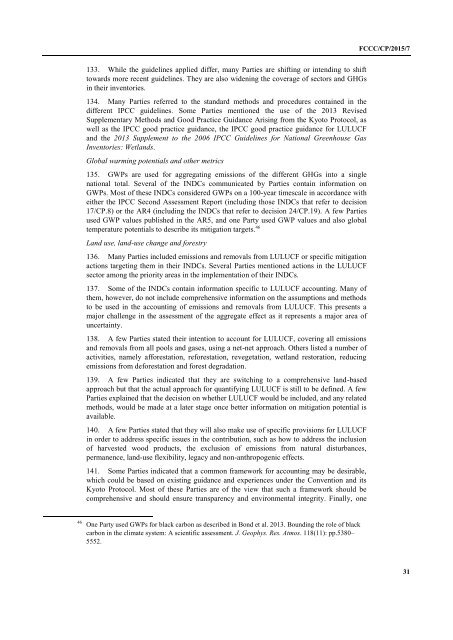FCCC/CP/2015/7
1PYuHQM
1PYuHQM
You also want an ePaper? Increase the reach of your titles
YUMPU automatically turns print PDFs into web optimized ePapers that Google loves.
<strong>FCCC</strong>/<strong>CP</strong>/<strong>2015</strong>/7<br />
133. While the guidelines applied differ, many Parties are shifting or intending to shift<br />
towards more recent guidelines. They are also widening the coverage of sectors and GHGs<br />
in their inventories.<br />
134. Many Parties referred to the standard methods and procedures contained in the<br />
different IPCC guidelines. Some Parties mentioned the use of the 2013 Revised<br />
Supplementary Methods and Good Practice Guidance Arising from the Kyoto Protocol, as<br />
well as the IPCC good practice guidance, the IPCC good practice guidance for LULUCF<br />
and the 2013 Supplement to the 2006 IPCC Guidelines for National Greenhouse Gas<br />
Inventories: Wetlands.<br />
Global warming potentials and other metrics<br />
135. GWPs are used for aggregating emissions of the different GHGs into a single<br />
national total. Several of the INDCs communicated by Parties contain information on<br />
GWPs. Most of these INDCs considered GWPs on a 100-year timescale in accordance with<br />
either the IPCC Second Assessment Report (including those INDCs that refer to decision<br />
17/<strong>CP</strong>.8) or the AR4 (including the INDCs that refer to decision 24/<strong>CP</strong>.19). A few Parties<br />
used GWP values published in the AR5, and one Party used GWP values and also global<br />
temperature potentials to describe its mitigation targets. 46<br />
Land use, land-use change and forestry<br />
136. Many Parties included emissions and removals from LULUCF or specific mitigation<br />
actions targeting them in their INDCs. Several Parties mentioned actions in the LULUCF<br />
sector among the priority areas in the implementation of their INDCs.<br />
137. Some of the INDCs contain information specific to LULUCF accounting. Many of<br />
them, however, do not include comprehensive information on the assumptions and methods<br />
to be used in the accounting of emissions and removals from LULUCF. This presents a<br />
major challenge in the assessment of the aggregate effect as it represents a major area of<br />
uncertainty.<br />
138. A few Parties stated their intention to account for LULUCF, covering all emissions<br />
and removals from all pools and gases, using a net-net approach. Others listed a number of<br />
activities, namely afforestation, reforestation, revegetation, wetland restoration, reducing<br />
emissions from deforestation and forest degradation.<br />
139. A few Parties indicated that they are switching to a comprehensive land-based<br />
approach but that the actual approach for quantifying LULUCF is still to be defined. A few<br />
Parties explained that the decision on whether LULUCF would be included, and any related<br />
methods, would be made at a later stage once better information on mitigation potential is<br />
available.<br />
140. A few Parties stated that they will also make use of specific provisions for LULUCF<br />
in order to address specific issues in the contribution, such as how to address the inclusion<br />
of harvested wood products, the exclusion of emissions from natural disturbances,<br />
permanence, land-use flexibility, legacy and non-anthropogenic effects.<br />
141. Some Parties indicated that a common framework for accounting may be desirable,<br />
which could be based on existing guidance and experiences under the Convention and its<br />
Kyoto Protocol. Most of these Parties are of the view that such a framework should be<br />
comprehensive and should ensure transparency and environmental integrity. Finally, one<br />
46 One Party used GWPs for black carbon as described in Bond et al. 2013. Bounding the role of black<br />
carbon in the climate system: A scientific assessment. J. Geophys. Res. Atmos. 118(11): pp.5380–<br />
5552.<br />
31


